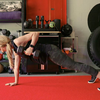How to Add Weight to Your Training for Maximum Strength Gains
Benefits of Adding Weights To Your Workout Routine
Build Muscle
One of the most apparent benefits of lifting weights is that it can help you build muscle. When you lift weights, you create tiny tears in your muscles. As your muscles repair these tears, they grow stronger and larger. This process is known as muscle hypertrophy.
Burn Fat
Lifting weights can also help you burn fat. When you lift weights, your body must use energy (calories) to repair your muscles. This means that your body will need to burn more calories to recover from a weightlifting session than it would from other types of exercise, such as jogging or biking.
Weight lifting exercises can also help you burn fat by increasing your metabolism. When you build muscle, your body requires more energy (calories) to maintain that muscle. This means your metabolism will be higher, and you will burn more calories even when you're resting.
Improve Bone Health
Lifting weights can also improve your bone health. When you lift weights, the stress on your bones stimulates the growth of new bone tissue. This can help prevent osteoporosis, a loss of bone density that can lead to fractures.
Reduce Injury Risk
In addition, lifting weights can reduce your risk of injury. Strong muscles protect your joints from injuries like ACL tears or sprains. Weightlifting can also help improve your balance and coordination, reducing your risk of injury.
A 3-Step Approach To Increase The Amount Of Weight You Lift
Getting bigger, stronger, and more muscular isn't rocket science (far from it), but you do need a plan of action if you expect to be successful.
To help with this, I'm going to give you a simple formula that you should follow if you want to make steady gains in the gym.
Step 1: Define your rep range
One of the first things you need to do if you're looking to really increase the amount of weight you lift is to define your rep ranges. Many people just pick out a weight (somewhat randomly), and then lift it for however many reps they can get, but this isn't the most effective strategy for muscle growth or strength training progress. Instead, you want to pick a specific rep range for each exercise to help guide your performance and apply progressive overload.
Common rep ranges for hypertrophy and strength include 4–6, 6–8, and 8–10 reps, but there’s no universal rule. The key is to choose a rep range that aligns with your fitness goals (whether that’s building muscle, improving weightlifting performance, or increasing muscular strength) and stick to it consistently. Structured rep ranges support better gym workout results and help track your lifting progression more effectively.
Step 2: Figure out your starting weight
Now once you've decided on the rep range for each exercise, the next thing to do is to figure out your starting weight. This step is crucial for establishing a baseline in your strength training routine.
Depending on your previous experience, this may be either lighter or heavier than you’re used to. For instance, if you’ve generally been doing higher reps and now shift to a 4-6 rep range, you’ll likely need to lift heavier to stimulate muscle hypertrophy.
It may take a bit of trial and error to figure this out the first time for each exercise, but the goal is to find the amount of weight where you are only able to hit the low number of your chosen rep range. So, if you’re working in the 4-6 rep range for bench press, start with the amount of weight where you can get 4 reps, but not 5. This helps establish an ideal weightlifting starting point for progressive overload, ensuring continual gains in muscle mass and strength development.
Step 3: Focus on steadily increasing reps/weight
The final step is to focus on gradually increasing either reps or the weight lifted every time you train - the core principle of progressive overload in strength training. This is where the rep range that you defined in step 1 comes in. Say you start out bench pressing 155 pounds for 4 reps during your first workout. Then, for the next workout, you are able to do 5 reps of that same weight. And then the next workout, you are able to get 6 reps of that weight, reaching the top of your rep range. At that point, it’s time to increase the load, maybe to 165 lbs, and aim to hit the bottom the rep range with the new, heavier weight.
This method ensures ongoing muscle adaptation and avoids plateaus in strength training. Realistically, you won’t always hit new numbers every session, especially as you advance, but aiming for consistent progression is key. By doing this, you’re ensuring optimal muscle building, improved workout performance, and long-term success in your resistance training program.

How Fast Should You Expect To Increase The Amount Of Weight You Lift?
This varies considerably depending on whether you're a beginner, an intermediate, or an advanced weight lifter.
Beginner Lifters
If you're newer to lifting weights (less than a year), or haven't trained properly before, then you can typically increase very quickly, and often expect to jump 5-10 pounds each week, especially for the major compound exercises (bench press, deadlift, squat, etc).
Intermediate Lifters
If you're an intermediate lifter (1-3 years of experience training properly), then you probably won't increase your weights each week, but you should still reliably be able to make progress with your reps, allowing for weight increases every 2-3 weeks.
Advanced Lifters
If you're a more advanced lifter (more than 3 years of training properly), then things will be slower. You may not even increase reps each week, and aiming for 5-10 pounds per month on each major exercise becomes a lot more realistic.
But at that point, you won’t care as much, since you’ll already be very strong and lifting a lot of weight anyway!
Now, of course, all of this assumes that you’re being consistent with your workouts and not missing too many days. And that you’re actually pushing yourself hard each time you work out, and not just going through the motions.
Other Easy Ways To Add Weight To Your Training
When it comes to increasing the intensity of your workouts, adding weight is one of the most effective ways to progress. While the classic approach is increasing the weight on your barbell, there are several other easy and effective ways to add weight to your training routine. In this guide, we’ll explore some alternative methods, including using dumbbells, resistance bands, and other tools that can help you increase the weight you lift and push your body to new limits.
1. Use Dumbbells for Increased Flexibility and Load
Dumbbells are one of the most versatile tools to add weight to your training. Unlike barbells, which can restrict your range of motion, dumbbells allow for a greater range of movement and help you target specific muscle groups more effectively. Adding dumbbell exercises to your workout routine can increase the load on your muscles and improve muscle symmetry.
Dumbbell Exercises for Strength & HypertrophyIncorporate dumbbell presses, dumbbell rows, and dumbbell lunges to engage more stabilizer muscles. Dumbbell Exercises for Strength & Hypertrophy
Adjustable Dumbbells: If you're working out at home, consider investing in adjustable dumbbells. They offer a range of weights in a single set, making it easy to progressively increase your load during your workouts.

2. Use Resistance Bands for Added Tension
Resistance bands are another simple way to add weight and resistance to your workout without using traditional weights. These bands work by providing progressive resistance, which increases the load as you stretch them.
How to Use Resistance Bands: You can attach them to a barbell, dumbbells, or use them for bodyweight exercises like squats, push-ups, and deadlifts. They add extra tension throughout the movement, making each rep more challenging.
Benefits: Resistance bands help improve muscle activation and are great for working on weak points in your lifts, such as the lockout phase in bench presses or squats. Plus, they’re portable and easy to incorporate into any workout routine, especially for home workouts.

3. Try Kettlebell Training for Dynamic Movements
Kettlebells are excellent for adding both weight and dynamic movements to your training. Unlike traditional weights, kettlebells challenge your muscles in unique ways by adding unilateral (one-sided) load and incorporating dynamic movements that improve mobility, explosiveness, and core strength.
Kettlebell Exercises: Some popular kettlebell exercises include swings, snatches, and goblet squats. These exercises target multiple muscle groups at once, offering a high-intensity workout that burns fat while building strength.
Versatility: Kettlebells are also ideal for full-body workouts and improving cardiovascular fitness. Their versatility makes them perfect for HIIT (High-Intensity Interval Training) circuits that incorporate both strength and conditioning elements.

Essential Tips for Weight Training Beginners
Have A Clear Plan
Before you start lifting weights, it is crucial to have a clear plan. This means having specific goals in mind and knowing which exercises you will need to do to achieve those goals. It is essential to start slowly and gradually increase the weight you lift. This will help reduce your risk of injury and ensure that you are using the proper form.
Focus On Quality, Not Quantity
When lifting weights, it is essential to focus on quality, not quantity. This means doing weight lifting exercises with proper form and using the right amount of weight. Few reps with a heavy weight are better than using a lighter weight for more reps. This will help you build more muscle and get stronger.
Be Consistent
The most important thing to remember when lifting weights is to be consistent. This means working out regularly and not skipping workouts. If you miss a workout, don't try to make up for it by doing two workouts the next day. This will only increase your risk of injury. Also, don't try to lift too much weight too quickly. This will only lead to frustration and cause you to give up.
Listen To Your Body
It is crucial to listen to your body. If something feels wrong or you start to feel pain, stop what you do. Rest for a few days, and then try again. If the pain persists, see a doctor. Never try to push through pain, as this can lead to serious injury.
Make Sure Your Diet Supports Your Weightlifting Goals
A healthy diet is an integral part of any fitness plan. This is especially true if you lift weights, as you need to ensure your body has enough energy to build muscle.A few things to keep in mind are to eat enough protein, get enough carbohydrates, and stay hydrated.
Final Thoughts
Incorporating weight into your training routine is one of the most effective ways to enhance your fitness results. Whether you choose to gradually increase the amount of weight you lift, add dumbbells, resistance bands, or kettlebells to your exercises, or focus on improving your rep range, the key to success lies in consistency and progressive overload. Remember to listen to your body, maintain proper form, and stay committed to your goals. With the right approach and dedication, you’ll see noticeable improvements in strength, muscle mass, and overall fitness, ensuring long-term progress and success in your training journey.




